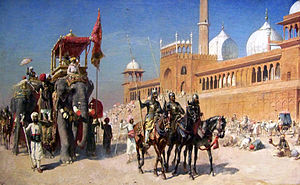Army of the Mughal Empire
Editing of this article by new or unregistered users is currently disabled to prevent sock puppets of blocked or banned users from editing it. See the protection policy and protection log for more details. If you cannot edit this article and you wish to make a change, you can submit an edit request, discuss changes on the talk page, request unprotection, log in, or create an account. |
This article may need to be rewritten to comply with Wikipedia's quality standards. (August 2015) |
| Mughal Army | |
|---|---|
 Great Mogul And His Court Returning From The Great Mosque At Delhi India — Oil Painting by American Artist Edwin Lord Weeks | |
| Founded | Late 15th Century |
| Disbanded | 1805 |
| Leadership | |
| Commander-in-Chief | Mughal emperor |
The Army of the Mughal Empire was the force by which the Mughal emperors established their empire in the 15th century and expanded it to its greatest extent at the beginning of the 18th century. Although its origins, like the Mughals themselves, were in the cavalry-based armies of central Asia, its essential form and structure was established by the empire's third emperor, Akbar.
The army had no regimental structure and the soldiers were not directly recruited by the emperor. Instead, individuals, such as nobles or local leaders, would recruit their own troops, referred to as a mansab, and contribute them to the army.
Recruitment
The soldiers of the Mughal Army were not recruited by the emperor himself but rather by chiefs and other leaders, who were known as Mansabdars. The Mansabdars were ranked based on the number of men that they had raised and the ranking system became known as mansab. The ranking system was first introduced by Akbar.
Artillery
See also
References
Further reading
- Edwardes, Stephen Meredyth; Garrett, Herbert Leonard Offley. Mughal Rule In India.
- Sharma, S. R. Mughal Empire in India: A Systematic Study Including Source Material.
